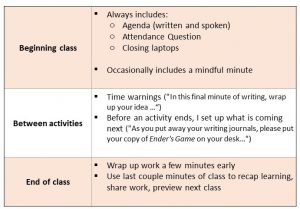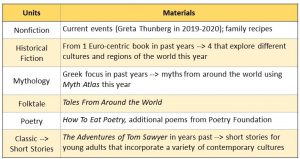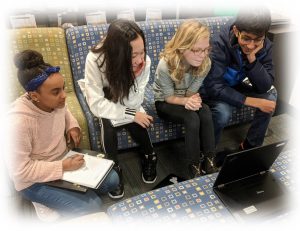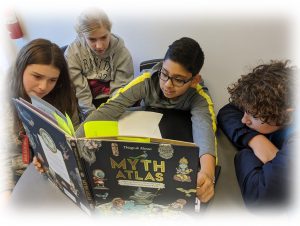(1) coaches and reinforces peer-to-peer dynamics that are appropriate and constructive
(2) communicates behavioral expectations that are appropriate to class activities
(3) develops a mutually respectful relationship with each student, instilling confidence that the teacher is invested in their success
(4) demonstrates cultural competence by promoting inclusivity
(5) designs and facilitates a classroom culture that promotes student preparedness, engagement, self-advocacy, perseverance, and collaboration
The culture in my classroom is currently built upon four critical components:

While these critical components are not necessarily visible to every student in every class on every day, they are the foundations upon which our respectful and trusting learning environment is built.
(1) coaches and reinforces peer-to-peer dynamics that are appropriate and constructive
Once the foundation of our classroom culture is solid, we begin to stretch students to expand their contributions. Healthy communication practices, especially when it comes to student-to-student communication, is at the heart of building a welcoming culture. I have incorporated many methods of teaching appropriate and constructive peer-to-peer communications over the years.
Modeling. First and foremost, I try to model positive communication. I confirm what I hear from students by restating their ideas. I refer to students’ ideas or questions as I build upon them. I phrase things in the positive rather than the negative. I acknowledge feelings and ideas, and try to build upon, rather than disregard, them. As students “see” my behaviors, they can begin to practice and internalize them, too.
Feedback. During the revision stage of the writing process, students usually have the chance to work with peers to improve their writing. To guide their interactions, I provide checklists and rubrics (non-scoring!) to focus conversations; together we compile ideas for ways to make useful yet constructive suggestions; I rotate through groups, offering ideas or helping students rephrase feedback. During the publishing stage, we share finished pieces and celebrate the positives with “Post-it Props” (positive note about a specific element of the piece written on a Post-it note and delivered to the author). I do my best to keep feedback focused on what is good and on what specific steps can be taken to improve the next draft.
Listening. A skill that is critical to learning and understanding peers is the ability to listen well to each other. In Intro to Lit and LT1, we practice listening during every class with the Attendance Question in the hopes that students will build some “muscle memory” around the task – someone else is talking, they might have a good idea, I should listen for it! I often ask students to listen to others as if they were going to have to respond personally to what was read/said.
(2) communicates behavioral expectations that are appropriate to class activities
In addition to the overall classroom expectations that we set at the beginning of each school year – listen to one another, be kind, do your best, be on time, etc. – there are behavioral expectations that I reiterate on a daily basis until they (hopefully) become rote and innate. Many of these expectations are centered around transitions between activities (see the table); others come into play when I introduce a new activity or begin to institute a new routine. I try to keep my word choice consistent from day to day, as well as provide visual cues, so that students learn to react on very little guidance from me. I’ve been called a “warm demander” (thanks, Sam Uzwack) when it comes to classroom expectations – I support, encourage, and kindly draw clear lines in the proverbial sand.
 Helping students transition smoothly from one activity to the next has been something I’ve worked on for several years and still modify depending on the makeup of the class. The 5th and 6th graders that I teach are 10, 11, and 12, and they still need lots of direction, forewarning, and specifics as they move from one activity to the next during the 85-minute blocks. Clear guidelines have myriad benefits, including my own ability to corral and maintain control of the group and regular routines that help students anticipate changes and then act independently and responsibly. Some of the key transition points and techniques I use are identified in the table on the right.
Helping students transition smoothly from one activity to the next has been something I’ve worked on for several years and still modify depending on the makeup of the class. The 5th and 6th graders that I teach are 10, 11, and 12, and they still need lots of direction, forewarning, and specifics as they move from one activity to the next during the 85-minute blocks. Clear guidelines have myriad benefits, including my own ability to corral and maintain control of the group and regular routines that help students anticipate changes and then act independently and responsibly. Some of the key transition points and techniques I use are identified in the table on the right.
(3) develops a mutually respectful relationship with each student, instilling confidence that the teacher is invested in their success
A mutually respectful relationship is built day after day, class after class, assignment after assignment, project after project. Development never stops, and each interaction is important. Relationships are built as I listen to students answer the day’s Attendance Question, as I point out a writing technique they employed in a poem, as they listen to me when I share a personal story from my weekend, and as we nod in the hallway between class and say, “Hey.” When people feel seen, when they feel that they belong to a group and are accepted for who they are, mutually respectful relationships exist.
There are, of course, students who don’t trust adults when they arrive at EPS and my job of establishing a strong relationship with them becomes more challenging. Perhaps last year’s teacher wasn’t kind. Perhaps they struggle with writing or reading, and try to hide that fact by working around it. Whatever the reason, the challenge exists and I work to overcome the obstacle. In these instances, my approach is to address the issue head on with direct conversations with the student. I state what I’ve noticed (“I’ve noticed that you make silly faces across the room when I’m not looking at you”). I state how that action appears to me (“That makes me feel like you and I are on different sides”). I state how we do things at EPS (“Your teachers want to help you grow and learn, and we do that by working together”). Building a trusting relationship with a hesitant student feels improbable in the beginning, but time and again I’ve learned that the partnership ends up stronger than those that are built with greater ease.
(4) demonstrates cultural competence by promoting inclusivity
Cultural competence, or awareness at the least, is increasingly critical in our global community. I promote inclusivity in most actions I take in the classroom, whether that’s learning how to pronounce my students’ names correctly, grouping students intentionally to balance academic strengths, or posting student work on the walls of my classroom. Our EPS culture is made up of so many diverse learners, histories, experiences, etc., that it would be irresponsible to not acknowledge or try to learn about them.

An overt attempt that I’ve made to incorporate more culturally diverse reading materials is evident in the table below. Alicia Hale (LT1 teaching partner) and I have spent the past couple of years updating our “book” list, trying to move from a somewhat Euro-centric set of readings to one that encompasses a broader swath of world cultures. The changes are in process (what isn’t?!) and will continue to be fluid as our world continues to change around us.
(5) designs and facilitates a classroom culture that promotes student preparedness, engagement, self-advocacy, perseverance, and collaboration
During the 19-20 school year, I newly implemented a couple of elements in my LT1 and Intro to Lit classrooms that I hoped would promote preparedness, engagement, self-advocacy, perseverance, and collaboration. One was aimed primarily at preparedness and was admittedly old-school elementary: a classroom mailbox for each student. Each student had their own slot, their own space in an otherwise shared classroom. I used the mailboxes to return work and leave messages; students used them to store their writing journals, projects, and in-progress assignments. The organizational benefits were noticeable – students could (almost) always find their journals, and were therefore prepared to engage. A win!
The second element I introduced (together, again, with Alicia Hale) was called Station Rotations, a system promoted by Catlin Tucker. It looked something like this:
- 3-4 “stations” set up in the classroom all at once, each with a different activity
- 1:1 w/ teacher – where I could evaluate individual work and provide targeted, in-process feedback to students
- “Offline” station – where students got off the screen to read, draw, peer review, or physically move their bodies
- Online station – at which students watched a video, practiced vocab or grammar, or typed up a final draft
- In small, intentionally tailored groups, students rotate through each station over the course of the period
- I provide detailed directions and materials at each station; students must be self-sufficient at each station in order for me to be able to meet 1:1 with each student
- Content and activities match and enhance the current unit
- Some stations will require a product to be turned in to show what students have learned
 Station Rotations promote preparedness, engagement, self-advocacy, perseverance, and collaboration all at the same time. In order to benefit from each station, students learned to bring proper materials, follow the directions and do the activity without teacher oversight, ask fellow group members for help, and work together to move through the content and stations in a timely manner. We practiced Station Rotations several times in both of my 5th- and 6th-grade classrooms, giving me insight as to what I needed to tweak and giving students multiple attempts to put their learning to use.
Station Rotations promote preparedness, engagement, self-advocacy, perseverance, and collaboration all at the same time. In order to benefit from each station, students learned to bring proper materials, follow the directions and do the activity without teacher oversight, ask fellow group members for help, and work together to move through the content and stations in a timely manner. We practiced Station Rotations several times in both of my 5th- and 6th-grade classrooms, giving me insight as to what I needed to tweak and giving students multiple attempts to put their learning to use.
 Several positive outcomes came from our Station Rotation experiences. One positive was the one-on-one time I gained with each student. I was able to assess their writing while it was in process, rather than after it was “done,” which gave me the opportunity to provide timely corrective feedback. Another positive is of course the independence that students had over their learning; if they didn’t attempt the work on their own, they wouldn’t learn it. A third positive was the break in between stations, which provided the opportunity for physical movement and time to shift focus from one activity to the next. Lastly, Station Rotations allowed me to create differentiated stations that allowed for different kinds of learners across the class period. So much good came from this system that I will continue to tweak and use it for many years to come!
Several positive outcomes came from our Station Rotation experiences. One positive was the one-on-one time I gained with each student. I was able to assess their writing while it was in process, rather than after it was “done,” which gave me the opportunity to provide timely corrective feedback. Another positive is of course the independence that students had over their learning; if they didn’t attempt the work on their own, they wouldn’t learn it. A third positive was the break in between stations, which provided the opportunity for physical movement and time to shift focus from one activity to the next. Lastly, Station Rotations allowed me to create differentiated stations that allowed for different kinds of learners across the class period. So much good came from this system that I will continue to tweak and use it for many years to come!